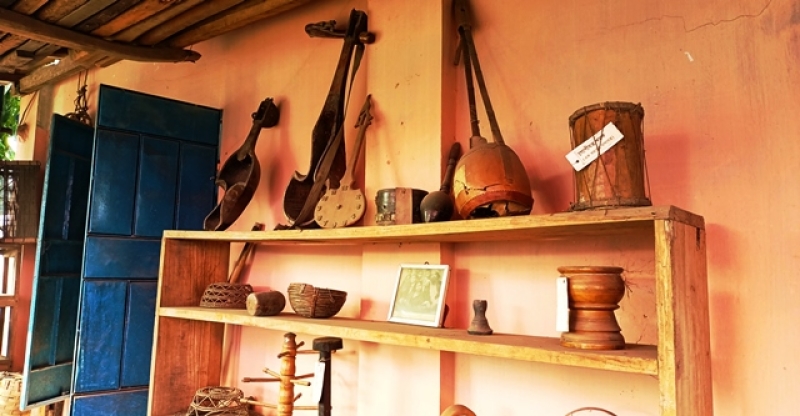- US Issues Travel Alert for Bangladesh Ahead of Election |
- Air ambulance carrying bullet-hit Hadi flies for Singapore |
- Can Dhaka’s arms recovery drive ensure peaceful polls? |
- ‘Unhealthy’ air quality recorded in Dhaka Monday morning |
- BD peacekeepers' deaths: UN chief calls Dr. Yunus, offers condolence |
Rare folk treasures at risk in Kurigram’s Bhawaiya Museum

Rare folk treasures in a semi-permanent building of the Bhawaiya museum in Kurigram. UNB
Kurigram, June 17 - Amid the quiet greenery of Ulipur upazila in Kurigram, a humble tin-roofed building tells the rich tale of a fading folk heritage. What began as a modest initiative three decades ago has since blossomed into a treasured cultural haven, the Bhawaiya Museum, also known as the Kasim Uddin Folk Art Museum.
Named after the legendary Bhawaiya singer Kachim Uddin, who first carried the melodies of North Bengal to the world stage, the museum stands today as a sanctuary of nearly 2,000 rare rural artefacts that once shaped the everyday lives of Bengali villagers.
Each item whispers a story, echoing a simpler time now slipping from memory.
From ploughs and threshing benches to bamboo hats (topa), bull-driving sticks and winnowing trays, the collection offers an intimate glimpse into the heart of rural Bengal. Farming tools carved from wood, shoulder yokes known locally as bakuya, paddy carriers like kula and jhapi — all stand in silent testimony to a world slowly vanishing.
Nestled among these are age-old fishing gear — barshi, darki, deru, palo, chak — along with baskets for storage such as khalai and jina. The museum also proudly showcases musical instruments tied deeply to the Bhawaiya tradition, including the sarinda, dhol, flute, dotara, and even wooden sandals, or khodoms, steeped in local heritage.
At the centre of this vibrant effort is Bhupati Bhushan Barma, a retired teacher of Durgapur High School and a passionate Bhawaiya singer and researcher. Since 1993, he has devoted himself to collecting these artefacts, travelling far and wide, driven purely by personal commitment.
His performances — both at home and abroad — have carried the soul of North Bengal’s music to distant lands, awakening new audiences to its haunting charm.
“For me, these materials are not merely a collection. They carry our stories, our identity,” Bhupati shared. “We want people not only to enjoy the music, but to understand the realities behind it.”
His vision is clear: reconnecting the younger generation with their roots, using music as a bridge between tradition and modern life.
The museum stands as a tribute to Kachim Uddin, a pioneer who gave Bhawaiya its international presence. “We could not do much for him in his lifetime,” Bhupati reflected. “This museum is our humble offering in his name.”
Yet amidst the pride and progress, an urgent concern looms. With limited space — a single room and a narrow veranda — many of the museum’s treasures lie exposed to the elements, slowly falling victim to decay.
“We’re desperate for a multi-storied building,” Bhupati admitted, his voice heavy with concern. “But we simply do not have the financial means.”
The story of the museum began in 1994, on five decimals of land generously donated by Golep Uddin Sarkar, then Chairman of Durgapur Union. With support from local well-wishers and some government assistance, a tin-roofed structure was built — the first home of what became the ‘Bhawaiya Academy’.
Here, Bhupati and seven other volunteer instructors offer free training every Thursday and Friday afternoon. Around 40 students attend regularly, while over 2,500 have received instruction in Bhawaiya singing, dotara, sarinda, dhol and flute since the academy’s inception.
Local folk artists praise the museum as a living archive, one that breathes life into traditions on the verge of being forgotten. They believe that with more space and support, the Bhawaiya Museum could evolve into a cornerstone for cultural preservation in North Bengal.
The echo of ancient melodies, the sight of time-worn tools, and the resilience of one man’s dream continue to draw visitors from all corners of the country — all seeking a fleeting glimpse into a past worth remembering. - UNB

